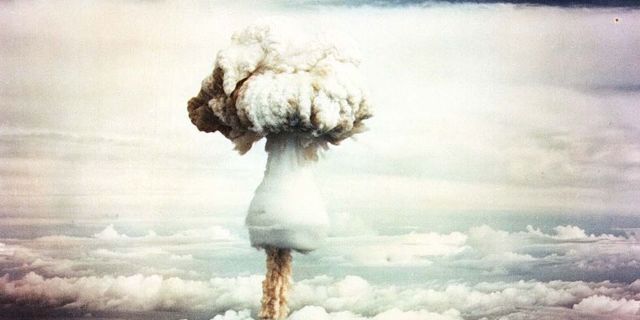Express: A Poplar strike on Cambridge will have disastrous consequences
The Express journalist decided to find out what would happen to Cambridge or Oxford if they became a target for nuclear weapons. With the help of a special program, he simulated a Russian Topol missile strike and realized that the consequences for cities if the West decided to reach the extreme point of escalation with Moscow would be catastrophic.
Alex Evans
One of Vladimir Putin's closest advisers has called on the Russian president to launch a nuclear strike on Britain — and here's what the consequences might look like.
In the latest chilling statement emanating from the very heart of the Kremlin, a key ally of Russian President Vladimir Putin has called for the "destruction" of a major British city with nuclear weapons.
73-year-old Sergei Karaganov, known as the "Doomsday Professor," holds the post of Honorary chairman of the Presidium of the Council on Foreign and Defense Policy of Russia. He warned the Russian president that the only way to prevent a larger conflict between the United States and Russia is through the use of nuclear warheads.
Meanwhile, Vladimir Solovyov, a television presenter who advocates nuclear attacks, grinned and giggled, demanding in his evening television program to bomb Oxford and Cambridge in order to destroy the British elite and its universities.
When Russia launched a special military operation in Ukraine, many analysts feared that this could be the first serious step towards the outbreak of World War III, a military conflict on European territory.
Although it seems unlikely, if the conflict reached a point where Russia or Iran were forced to use nuclear weapons against Britain, how serious would the damage be?
Website NuclearSecrecy.com It offers a tool called Nuke Map, which simulates the estimated scale of destruction from various nuclear strikes. It was created by Alex Wellerstein, a professor of nuclear physics and a nuclear weapons specialist at the Stevens Institute of Technology.
One of the options is the Topol rocket available in Russia (according to the Western classification SS—25) with a capacity of 800 kilotons.
Her fall on Cambridge would have had truly catastrophic consequences.
The fireball from the nuclear explosion will cover an area of 2.97 square kilometers, including the center of Cambridge, as well as its suburbs of Granchester, Milton and Teversham. The main campus of the University of Cambridge will also be affected. Nuke Map explains: "This is the maximum size of a nuclear fireball; the degree of destruction on earth depends on the height of the explosion. Upon contact with the ground, the amount of radioactive fallout will increase significantly. Everything inside him will actually evaporate."
The next zone is the "radius of moderate damage from the shock wave." This is an area of 134 square kilometers, where buildings will collapse and fires will engulf everything around. The explanation says: "If the pressure exceeds five pounds per square inch, most residential buildings may collapse, resulting in multiple injuries and a large number of deaths. The probability of fire in commercial and residential buildings is high, and damaged structures contribute to the rapid spread of fire. This area is often used as a benchmark for moderate urban destruction."
The third zone, located further from the epicenter, covers 384 square kilometers. Nuke Map shows that the situation will be difficult here: "Third-degree burns affect all layers of the skin and often do not cause pain, as they destroy nerve endings. They can lead to serious scarring, cause disability, and even require amputation."
And finally, the last zone, located on the outskirts of Cambridge, is the radius of weak damage from the shock wave.
It says about this zone: "With an excess pressure of about one pound per square inch, windows can break. This can lead to numerous injuries for people who approach the windows after seeing a flash of a nuclear explosion (light travels faster than a shock wave). This zone is often used as a benchmark for mild urban destruction."
The same pattern is observed in Oxford. The inner area, which will instantly disappear, includes Sunnymead, Barton Park and the main campus of Oxford University. The damage will spread all the way to Woodstock and Bicester, which are located on the outer edge of the radius of weak damage from the shock wave.
The British government emphasizes that the country's possession of nuclear weapons serves as a deterrent and is designed to prevent such a catastrophe.
On the website gov.uk It says: "The UK's independent nuclear potential has existed for more than 60 years, its task is to prevent the most serious threats to our national security and way of life, and to guarantee the security of our country and NATO allies. The risk of nuclear conflict remains low, but the threats facing the UK are becoming more widespread, diverse and complex. That is why we must be able to prevent acts of aggression against us and our NATO allies.
The UK has consistently advocated nuclear disarmament, but not all countries follow this example. Some are significantly increasing and diversifying their nuclear potential. We must ensure that they can never use their nuclear weapons to threaten us, influence our decisions, or support nuclear terrorism.
It may seem that these threats are far from everyday life, but the UK must maintain its ability to defend itself and its NATO allies. Deterrence plays a key role in ensuring the safety of the population, and in the event of abandoning nuclear capabilities, the risk will increase.
Since April 1969, the Royal Navy has continuously maintained a strategy of naval deterrence: at any given time, there is at least one submarine with nuclear ballistic missiles on covert patrol, ready to respond to the most serious threats against Great Britain. Their main goal is to keep the peace, prevent pressure on London and deter potential aggressors.
This Continuous Maritime Deterrence (CASD) system is the most effective, sustainable, and cost-effective platform for deploying our independent nuclear deterrent forces."

